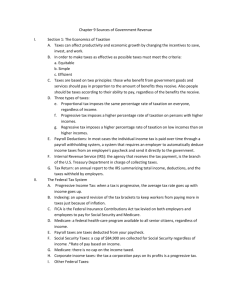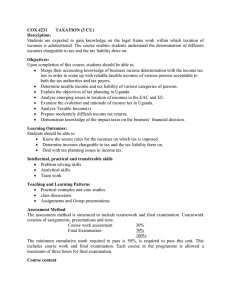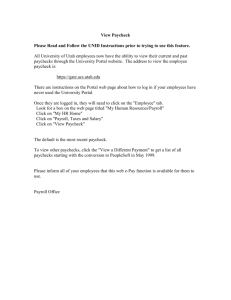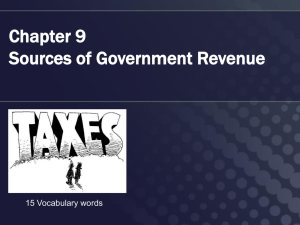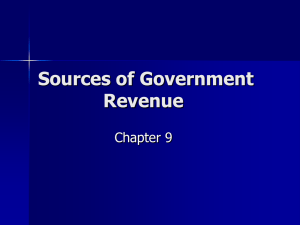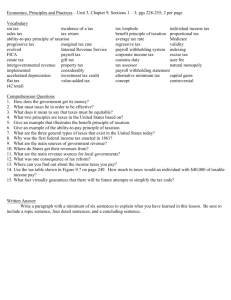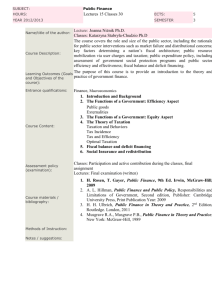CH. 9 Sources of Government Revenue
advertisement
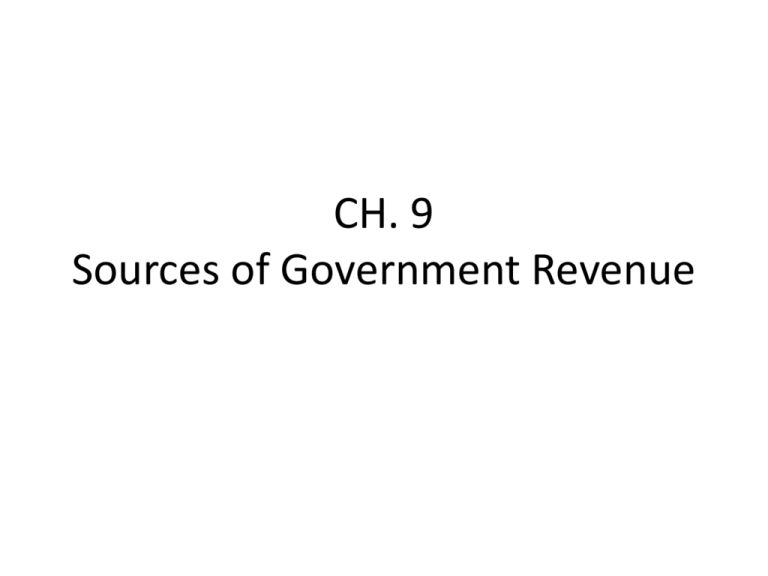
CH. 9 Sources of Government Revenue The Economics of Taxation • An enormous amount of money is required to run federal, state, and local governments – Think of the amounts of money we looked at in the last chapter for government spending – Where does all this money come from? • **Most local, state and federal government revenues come from TAXES!!** Two Principles of Taxation • Benefit Principle of Taxation: – Those who benefit from government goods and services should pay in proportion to the amount of benefits they receives – Example: Taxes on gasoline • Gas tax is built into price of gasoline at the pump, people who drive more than others pay more gas taxes and therefore pay for more of the upkeep of our nation’s highways Two Principles of Taxation • Ability-to-Pay Principle: – People should be taxed according to their ability to pay regardless of the benefits they receive – Example: individual income tax • Requires individuals with higher incomes to pay more than those with lower incomes Types of Taxes • Proportional Tax • Progressive Tax • Regressive Tax Proportional Tax • Charges the same percentage rate of taxation on everyone, regardless of income – If the income tax rate is 20%, a person with $10,000 in taxable income pays $2,000 in taxes while a person with $100,000 in taxable income pays $20,000. • Summary: – As income goes up, the percent of income paid in taxes stays the same Progressive Tax • Charges a higher percentage rate of taxation on persons with higher incomes – “the more you make, the more they take” – Claims not only a larger dollar amount but also a larger percentage of income as income increases • If the tax system requires a person to pay $1,000 on $10,000 of taxable income, $4,000 on $20,000 and $30,000 on $100,000 percent of income 10, 20, and 30 percent rises as income rises • Summary: – As income goes up, the percent of income paid in taxes goes up Regressive Tax • Charges a higher percentage rate of taxation on low incomes than on high incomes – If a person with a $10,000 income spends $5,000 on food and clothing, while a person with a $100,000 income spends $20,000 on the same essentials, if the state sales tax is 4%, the person with the lower income is paying a higher percentage of total income in taxes • Summary: – As income goes up, the percent of income paid in taxes goes down The Federal Tax System • Where does the federal government get its revenue? • Individual Income Taxes – Tax on people’s earnings automatically deducted from your paychecks • Corporate Income Taxes – Tax a corporation pays on its profits – Taxed separately from individuals because the corporation is recognized as a separate legal entity More Taxes…. • FICA Taxes (Social Insurance Payroll) – Federal Insurance Contributions Act – Paid by both employers and employees to pay for Social Security and Medicare (federal health-care program available to all senior citizens, regardless of income) – Also called payroll taxes because they are deducted from your paycheck Other Federal Taxes • Excise Tax- tax on manufacture or sale of selected items – Alcohol, tobacco, gasoline, telephone services • Estate Tax- tax on the transfer of property when a person dies • Gift Tax- tax on donations of money or wealth and is paid by the person who makes the gift – Used to make sure that wealthy people do not try to avoid taxes by giving away their estates before their deaths • Customs Duty- charge on goods brought in from other countries • The government uses these taxes for highways and airports, etc—and deposits others in the general fund • **One of the public goods that only the federal government provides is national defense** • Only two things you can count on in life: Death and Taxes!!! Types of Taxes we Spend State Government Revenues • A significant source of revenue for state governments comes from the sales tax – General tax charged on consumer purchases of nearly all products – A percentage of the purchase price which is added to the final price the consumer pays – Collected at the time of sale – Varies from state to state • Alaska, Delaware, Montana, New Hampshire, and Oregon do not have a general sales tax Local Government Revenues • A majority of revenues for local governments comes from the property tax – Tax on possessions such as real estate, buildings, furniture, automobiles, farm animals, stocks, bonds, and bank accounts – Real estate raises the most revenue of all the property taxes – Taxes on other personal property (except automobiles) is seldom collected because of the problem of determining value Examining Paychecks • Many of the taxes you pay to federal, state, and local governments are deducted directly from your paycheck • Payroll Withholding Statement – Summary statement attached to a paycheck that summarizes income, tax withholdings, and deductions • Gross Pay- amount you make prior to taxes • Net Pay- amount you make after taxes have been taken out – This is how much you will receive when you cash your paycheck • To figure out how much was deducted from your paycheck you: **TOTAL TAXES TAKEN OUT= Gross Pay- Net Pay**


